Literature Review: Socio-Ecological Determinants of Teenage Obesity
VerifiedAdded on 2020/07/23
|19
|5674
|31
Literature Review
AI Summary
This literature review delves into the multifaceted socio-ecological determinants of teenage obesity and overweight. It begins with an introduction emphasizing the importance of an in-depth analysis using published articles and journals. The review explores various factors contributing to childhood obesity, including socioeconomic status (parents' education, occupation, and income), dietary behaviors (calorie intake, soft drinks, snack foods, food portion sizes, fast foods, fruits and vegetables, diet frequency), physical activities (type, level, and sedentary activities), biological factors (age, sex, and race), and environmental influences (physical, social, and political environments). The review also addresses approaches to tackling childhood obesity, identifies knowledge gaps, and outlines the research purpose, questions, objectives, and significance of the study, including a conceptual model. The study highlights the complex interplay of these factors and their impact on teenage health, ultimately aiming to provide a comprehensive understanding of the issue.

Literature Review
(SOCIO-ECOLOGICAL DETERMINANTS OF TEENAGE
OBESITY AND OVERWEIGHT)
Table of Contents
(SOCIO-ECOLOGICAL DETERMINANTS OF TEENAGE
OBESITY AND OVERWEIGHT)
Table of Contents
Paraphrase This Document
Need a fresh take? Get an instant paraphrase of this document with our AI Paraphraser

CHAPTER 2: LITERATURE REVIEW.........................................................................................1
2.1 Introduction............................................................................................................................1
2.2 Determinants of childhood obesity........................................................................................1
2.2.1 Socioeconomic status......................................................................................................1
2.2.2.1 Parents education.........................................................................................................2
2.2.2.2 Parents occupation.......................................................................................................3
2.2.2.3 Parents income.............................................................................................................3
2.2.2.4 Knowledge gap............................................................................................................4
2.2.2 Dietary behaviour...........................................................................................................4
2.2.2.1 Calorie intake...............................................................................................................5
2.2.2.2 Soft drinks....................................................................................................................5
2.2.2.3 Snack foods..................................................................................................................5
2.2.2.4 Food portion sizes........................................................................................................5
2.2.2.5 Fast foods and fast food outlets...................................................................................6
2.2.2.6 Fruits and vegetables...................................................................................................6
2.2.2.7 Diet frequency.............................................................................................................6
2.2.2.8 Knowledge gap............................................................................................................6
2.2.3 Physical activities...........................................................................................................6
2.2.3.1 Type of physical activity.............................................................................................7
2.2.3.2 Level of physical activity.............................................................................................7
2.2.3.3 Sedentary activities......................................................................................................7
2.2.3.3 Knowledge gap............................................................................................................7
2.2.4 Biological factors............................................................................................................7
2.2.4.1 Age...............................................................................................................................7
2.2.4.2 Sex...............................................................................................................................8
2.2.4.3 Race.............................................................................................................................8
2.2.4.4 Knowledge gap............................................................................................................8
2.2.5 Environment...................................................................................................................8
2.2.5.1 Physical environment...................................................................................................8
2.2.5.1.1 Place of residence.....................................................................................................8
2.2.5.1.2 School environment..................................................................................................9
2.1 Introduction............................................................................................................................1
2.2 Determinants of childhood obesity........................................................................................1
2.2.1 Socioeconomic status......................................................................................................1
2.2.2.1 Parents education.........................................................................................................2
2.2.2.2 Parents occupation.......................................................................................................3
2.2.2.3 Parents income.............................................................................................................3
2.2.2.4 Knowledge gap............................................................................................................4
2.2.2 Dietary behaviour...........................................................................................................4
2.2.2.1 Calorie intake...............................................................................................................5
2.2.2.2 Soft drinks....................................................................................................................5
2.2.2.3 Snack foods..................................................................................................................5
2.2.2.4 Food portion sizes........................................................................................................5
2.2.2.5 Fast foods and fast food outlets...................................................................................6
2.2.2.6 Fruits and vegetables...................................................................................................6
2.2.2.7 Diet frequency.............................................................................................................6
2.2.2.8 Knowledge gap............................................................................................................6
2.2.3 Physical activities...........................................................................................................6
2.2.3.1 Type of physical activity.............................................................................................7
2.2.3.2 Level of physical activity.............................................................................................7
2.2.3.3 Sedentary activities......................................................................................................7
2.2.3.3 Knowledge gap............................................................................................................7
2.2.4 Biological factors............................................................................................................7
2.2.4.1 Age...............................................................................................................................7
2.2.4.2 Sex...............................................................................................................................8
2.2.4.3 Race.............................................................................................................................8
2.2.4.4 Knowledge gap............................................................................................................8
2.2.5 Environment...................................................................................................................8
2.2.5.1 Physical environment...................................................................................................8
2.2.5.1.1 Place of residence.....................................................................................................8
2.2.5.1.2 School environment..................................................................................................9
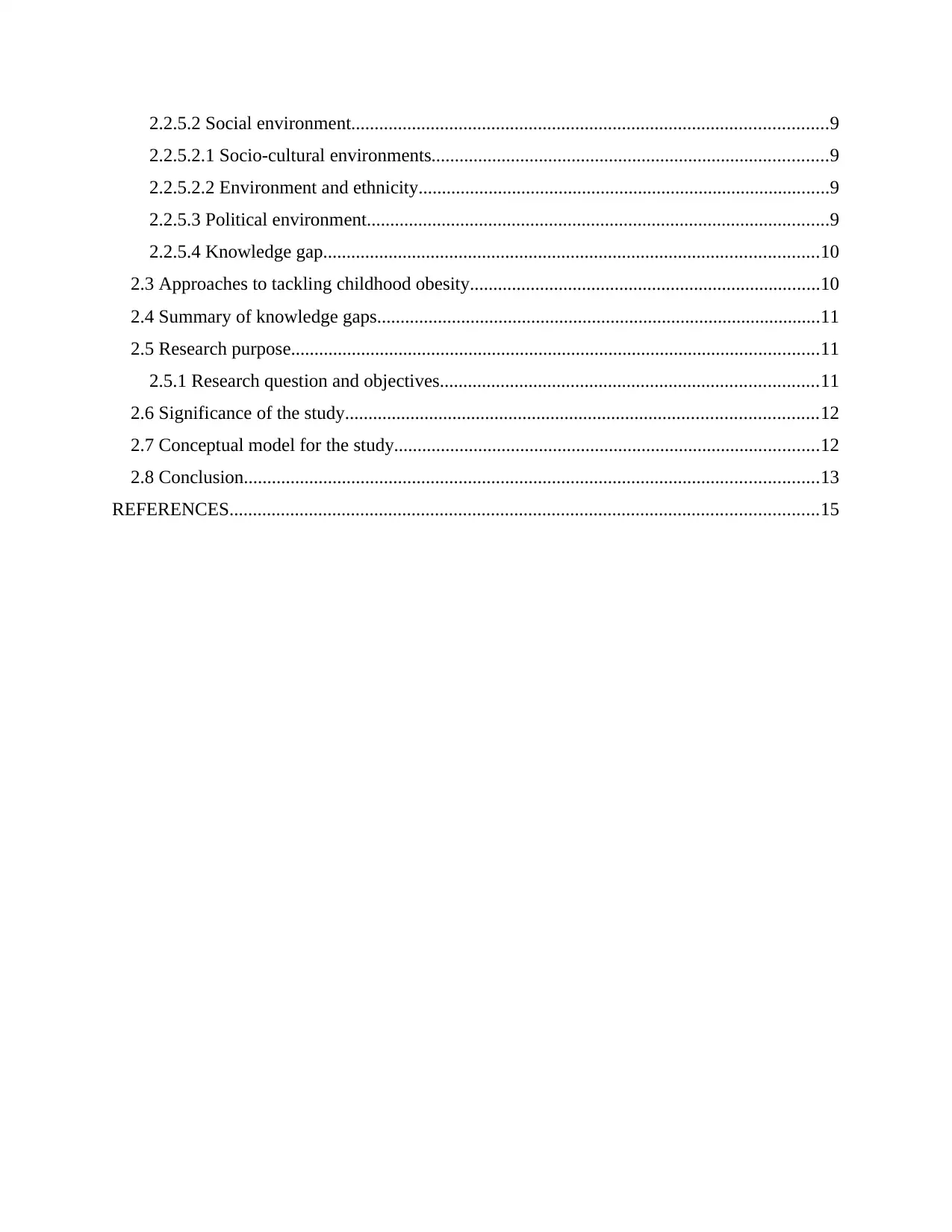
2.2.5.2 Social environment......................................................................................................9
2.2.5.2.1 Socio-cultural environments.....................................................................................9
2.2.5.2.2 Environment and ethnicity........................................................................................9
2.2.5.3 Political environment...................................................................................................9
2.2.5.4 Knowledge gap..........................................................................................................10
2.3 Approaches to tackling childhood obesity...........................................................................10
2.4 Summary of knowledge gaps...............................................................................................11
2.5 Research purpose.................................................................................................................11
2.5.1 Research question and objectives.................................................................................11
2.6 Significance of the study.....................................................................................................12
2.7 Conceptual model for the study...........................................................................................12
2.8 Conclusion...........................................................................................................................13
REFERENCES..............................................................................................................................15
2.2.5.2.1 Socio-cultural environments.....................................................................................9
2.2.5.2.2 Environment and ethnicity........................................................................................9
2.2.5.3 Political environment...................................................................................................9
2.2.5.4 Knowledge gap..........................................................................................................10
2.3 Approaches to tackling childhood obesity...........................................................................10
2.4 Summary of knowledge gaps...............................................................................................11
2.5 Research purpose.................................................................................................................11
2.5.1 Research question and objectives.................................................................................11
2.6 Significance of the study.....................................................................................................12
2.7 Conceptual model for the study...........................................................................................12
2.8 Conclusion...........................................................................................................................13
REFERENCES..............................................................................................................................15
⊘ This is a preview!⊘
Do you want full access?
Subscribe today to unlock all pages.

Trusted by 1+ million students worldwide

CHAPTER 2: LITERATURE REVIEW
2.1 Introduction
The investigator has to conduct an in-depth analysis so for this information should be
reviewed from different published articles and journals. Present section of dissertation represents
different concepts and theories which are related to the current topic. In this, researcher reviewed
different academic literatures so that relevant aspects can be gathered and field of study can also
be carried out in an effective manner. Here, information is collected through various sources like
books, journals, articles, research papers, magazines and so on. Through this, scholar can create a
base for their own research which will help them in drawing an effective conclusion. By getting
the views of different authors, more reliable and valuable outcome can be achieved. Due to
which specified research objectives can be achieved and questions can be resolved in an effective
way. The present research is based on the social and ecological factors which affect the teenage
obesity and overweight. After conducting this it can be identified that how different factors can
affect the health of different individuals. Furthermore, the research gap can be identified on the
basis of outcomes which are derived from different previous literatures.
2.2 Determinants of childhood obesity
Childhood obesity is a kind of condition in which due to excess weight the health of
children is get affected in negative manner. Karnik and Kanekar (2012) stated that obesity can be
diagnosed on the basis of Body Mass index (BMI) and it is measured on the basis of age, sex,
height. There are various determinates of obesity like socioeconomic, dietary, physical,
biological and environment. These are explained in further report so overall field of study can be
carried out in an effective way.
2.2.1 Socioeconomic status
As per the views of Wang and Lim (2012) socioeconomic is a combination of sociological
and economic which is used to measure the work experience of an individual and their social
status as compare to other people. The status and class can be measured on the basis of income,
occupation and education. Through this, economic difference can be established in a society so a
distinctive image can be created. This can be broken into some levels like low, high and medium
which explain that an individual’s family is fall down into these categories. On the other hand, it
1
2.1 Introduction
The investigator has to conduct an in-depth analysis so for this information should be
reviewed from different published articles and journals. Present section of dissertation represents
different concepts and theories which are related to the current topic. In this, researcher reviewed
different academic literatures so that relevant aspects can be gathered and field of study can also
be carried out in an effective manner. Here, information is collected through various sources like
books, journals, articles, research papers, magazines and so on. Through this, scholar can create a
base for their own research which will help them in drawing an effective conclusion. By getting
the views of different authors, more reliable and valuable outcome can be achieved. Due to
which specified research objectives can be achieved and questions can be resolved in an effective
way. The present research is based on the social and ecological factors which affect the teenage
obesity and overweight. After conducting this it can be identified that how different factors can
affect the health of different individuals. Furthermore, the research gap can be identified on the
basis of outcomes which are derived from different previous literatures.
2.2 Determinants of childhood obesity
Childhood obesity is a kind of condition in which due to excess weight the health of
children is get affected in negative manner. Karnik and Kanekar (2012) stated that obesity can be
diagnosed on the basis of Body Mass index (BMI) and it is measured on the basis of age, sex,
height. There are various determinates of obesity like socioeconomic, dietary, physical,
biological and environment. These are explained in further report so overall field of study can be
carried out in an effective way.
2.2.1 Socioeconomic status
As per the views of Wang and Lim (2012) socioeconomic is a combination of sociological
and economic which is used to measure the work experience of an individual and their social
status as compare to other people. The status and class can be measured on the basis of income,
occupation and education. Through this, economic difference can be established in a society so a
distinctive image can be created. This can be broken into some levels like low, high and medium
which explain that an individual’s family is fall down into these categories. On the other hand, it
1
Paraphrase This Document
Need a fresh take? Get an instant paraphrase of this document with our AI Paraphraser
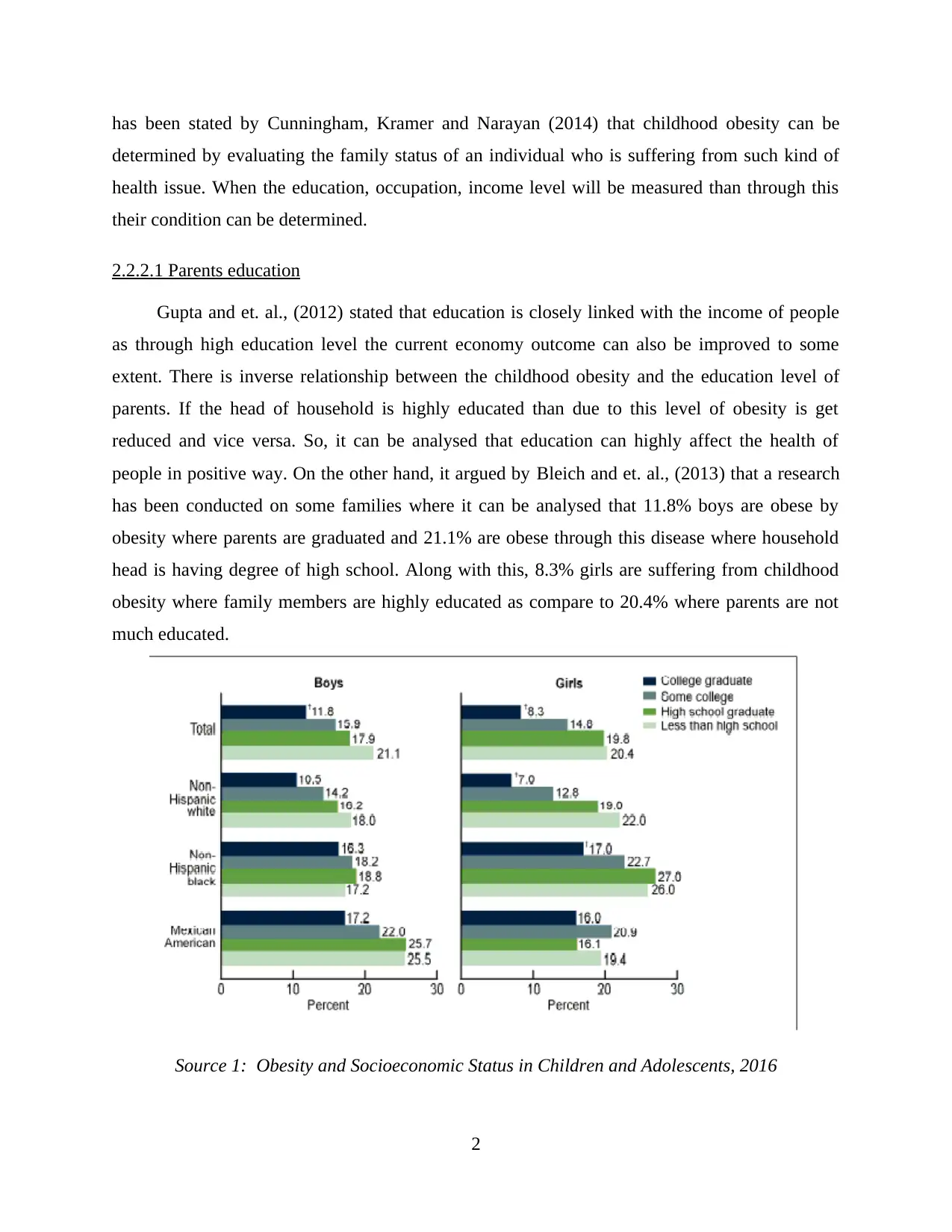
has been stated by Cunningham, Kramer and Narayan (2014) that childhood obesity can be
determined by evaluating the family status of an individual who is suffering from such kind of
health issue. When the education, occupation, income level will be measured than through this
their condition can be determined.
2.2.2.1 Parents education
Gupta and et. al., (2012) stated that education is closely linked with the income of people
as through high education level the current economy outcome can also be improved to some
extent. There is inverse relationship between the childhood obesity and the education level of
parents. If the head of household is highly educated than due to this level of obesity is get
reduced and vice versa. So, it can be analysed that education can highly affect the health of
people in positive way. On the other hand, it argued by Bleich and et. al., (2013) that a research
has been conducted on some families where it can be analysed that 11.8% boys are obese by
obesity where parents are graduated and 21.1% are obese through this disease where household
head is having degree of high school. Along with this, 8.3% girls are suffering from childhood
obesity where family members are highly educated as compare to 20.4% where parents are not
much educated.
Source 1: Obesity and Socioeconomic Status in Children and Adolescents, 2016
2
determined by evaluating the family status of an individual who is suffering from such kind of
health issue. When the education, occupation, income level will be measured than through this
their condition can be determined.
2.2.2.1 Parents education
Gupta and et. al., (2012) stated that education is closely linked with the income of people
as through high education level the current economy outcome can also be improved to some
extent. There is inverse relationship between the childhood obesity and the education level of
parents. If the head of household is highly educated than due to this level of obesity is get
reduced and vice versa. So, it can be analysed that education can highly affect the health of
people in positive way. On the other hand, it argued by Bleich and et. al., (2013) that a research
has been conducted on some families where it can be analysed that 11.8% boys are obese by
obesity where parents are graduated and 21.1% are obese through this disease where household
head is having degree of high school. Along with this, 8.3% girls are suffering from childhood
obesity where family members are highly educated as compare to 20.4% where parents are not
much educated.
Source 1: Obesity and Socioeconomic Status in Children and Adolescents, 2016
2
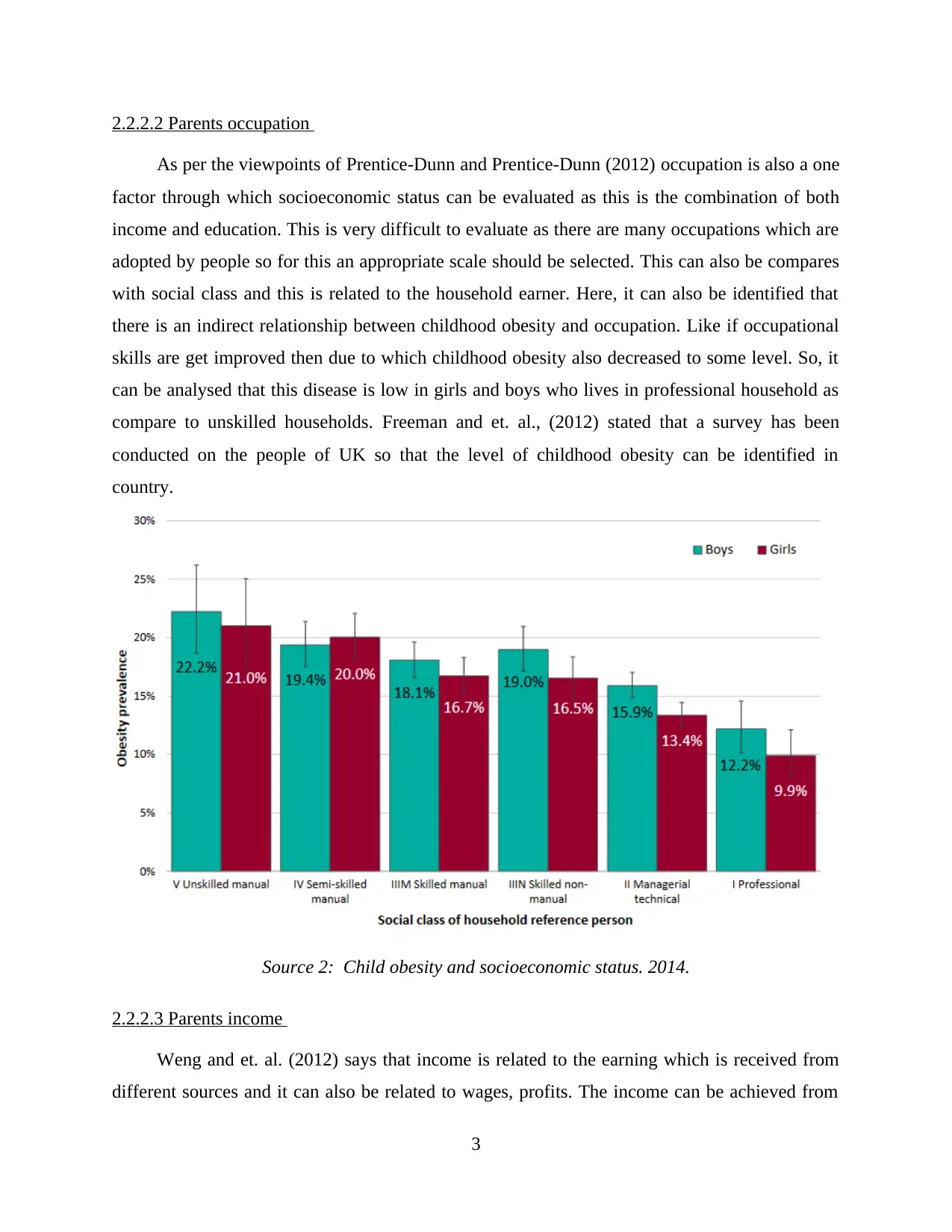
2.2.2.2 Parents occupation
As per the viewpoints of Prentice-Dunn and Prentice-Dunn (2012) occupation is also a one
factor through which socioeconomic status can be evaluated as this is the combination of both
income and education. This is very difficult to evaluate as there are many occupations which are
adopted by people so for this an appropriate scale should be selected. This can also be compares
with social class and this is related to the household earner. Here, it can also be identified that
there is an indirect relationship between childhood obesity and occupation. Like if occupational
skills are get improved then due to which childhood obesity also decreased to some level. So, it
can be analysed that this disease is low in girls and boys who lives in professional household as
compare to unskilled households. Freeman and et. al., (2012) stated that a survey has been
conducted on the people of UK so that the level of childhood obesity can be identified in
country.
Source 2: Child obesity and socioeconomic status. 2014.
2.2.2.3 Parents income
Weng and et. al. (2012) says that income is related to the earning which is received from
different sources and it can also be related to wages, profits. The income can be achieved from
3
As per the viewpoints of Prentice-Dunn and Prentice-Dunn (2012) occupation is also a one
factor through which socioeconomic status can be evaluated as this is the combination of both
income and education. This is very difficult to evaluate as there are many occupations which are
adopted by people so for this an appropriate scale should be selected. This can also be compares
with social class and this is related to the household earner. Here, it can also be identified that
there is an indirect relationship between childhood obesity and occupation. Like if occupational
skills are get improved then due to which childhood obesity also decreased to some level. So, it
can be analysed that this disease is low in girls and boys who lives in professional household as
compare to unskilled households. Freeman and et. al., (2012) stated that a survey has been
conducted on the people of UK so that the level of childhood obesity can be identified in
country.
Source 2: Child obesity and socioeconomic status. 2014.
2.2.2.3 Parents income
Weng and et. al. (2012) says that income is related to the earning which is received from
different sources and it can also be related to wages, profits. The income can be achieved from
3
⊘ This is a preview!⊘
Do you want full access?
Subscribe today to unlock all pages.

Trusted by 1+ million students worldwide
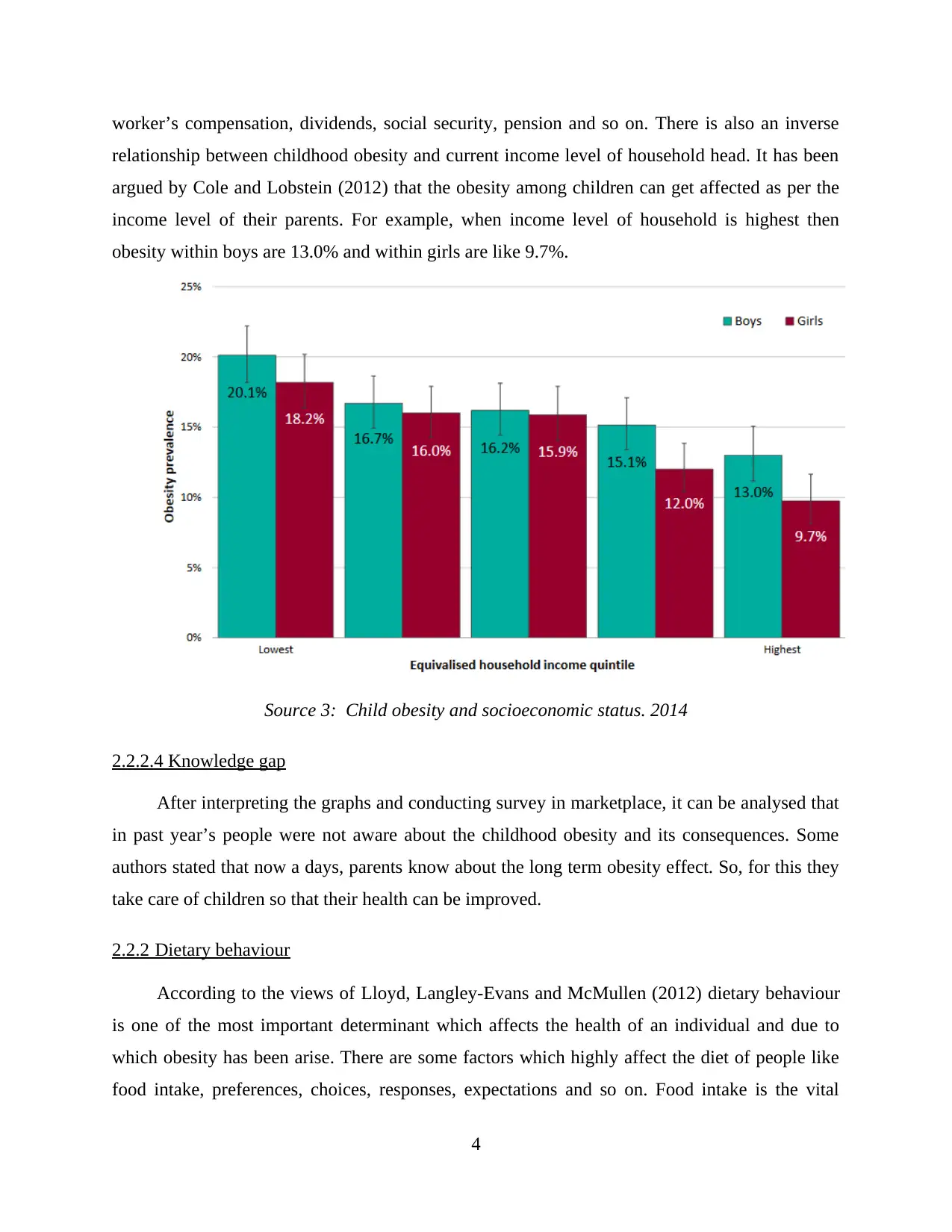
worker’s compensation, dividends, social security, pension and so on. There is also an inverse
relationship between childhood obesity and current income level of household head. It has been
argued by Cole and Lobstein (2012) that the obesity among children can get affected as per the
income level of their parents. For example, when income level of household is highest then
obesity within boys are 13.0% and within girls are like 9.7%.
Source 3: Child obesity and socioeconomic status. 2014
2.2.2.4 Knowledge gap
After interpreting the graphs and conducting survey in marketplace, it can be analysed that
in past year’s people were not aware about the childhood obesity and its consequences. Some
authors stated that now a days, parents know about the long term obesity effect. So, for this they
take care of children so that their health can be improved.
2.2.2 Dietary behaviour
According to the views of Lloyd, Langley-Evans and McMullen (2012) dietary behaviour
is one of the most important determinant which affects the health of an individual and due to
which obesity has been arise. There are some factors which highly affect the diet of people like
food intake, preferences, choices, responses, expectations and so on. Food intake is the vital
4
relationship between childhood obesity and current income level of household head. It has been
argued by Cole and Lobstein (2012) that the obesity among children can get affected as per the
income level of their parents. For example, when income level of household is highest then
obesity within boys are 13.0% and within girls are like 9.7%.
Source 3: Child obesity and socioeconomic status. 2014
2.2.2.4 Knowledge gap
After interpreting the graphs and conducting survey in marketplace, it can be analysed that
in past year’s people were not aware about the childhood obesity and its consequences. Some
authors stated that now a days, parents know about the long term obesity effect. So, for this they
take care of children so that their health can be improved.
2.2.2 Dietary behaviour
According to the views of Lloyd, Langley-Evans and McMullen (2012) dietary behaviour
is one of the most important determinant which affects the health of an individual and due to
which obesity has been arise. There are some factors which highly affect the diet of people like
food intake, preferences, choices, responses, expectations and so on. Food intake is the vital
4
Paraphrase This Document
Need a fresh take? Get an instant paraphrase of this document with our AI Paraphraser
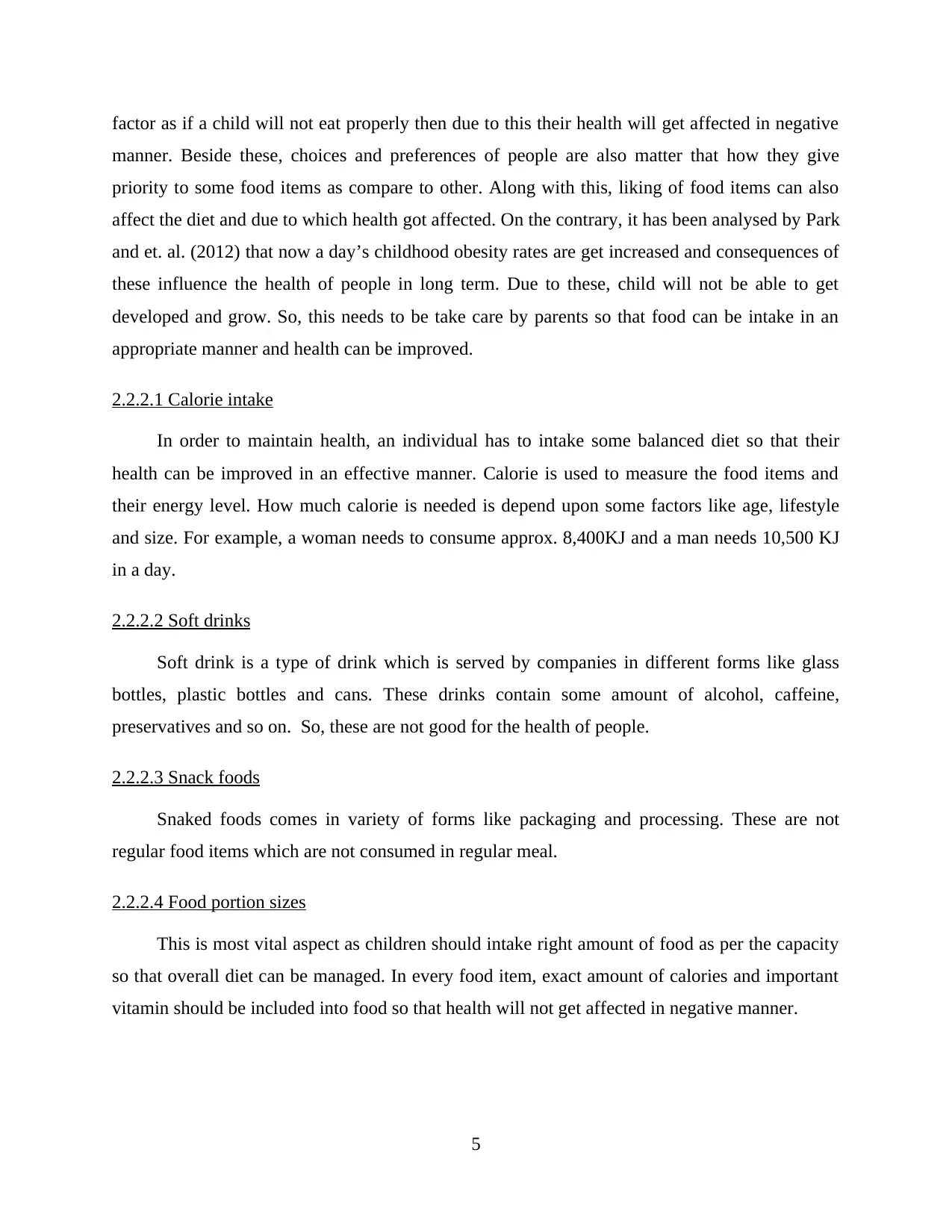
factor as if a child will not eat properly then due to this their health will get affected in negative
manner. Beside these, choices and preferences of people are also matter that how they give
priority to some food items as compare to other. Along with this, liking of food items can also
affect the diet and due to which health got affected. On the contrary, it has been analysed by Park
and et. al. (2012) that now a day’s childhood obesity rates are get increased and consequences of
these influence the health of people in long term. Due to these, child will not be able to get
developed and grow. So, this needs to be take care by parents so that food can be intake in an
appropriate manner and health can be improved.
2.2.2.1 Calorie intake
In order to maintain health, an individual has to intake some balanced diet so that their
health can be improved in an effective manner. Calorie is used to measure the food items and
their energy level. How much calorie is needed is depend upon some factors like age, lifestyle
and size. For example, a woman needs to consume approx. 8,400KJ and a man needs 10,500 KJ
in a day.
2.2.2.2 Soft drinks
Soft drink is a type of drink which is served by companies in different forms like glass
bottles, plastic bottles and cans. These drinks contain some amount of alcohol, caffeine,
preservatives and so on. So, these are not good for the health of people.
2.2.2.3 Snack foods
Snaked foods comes in variety of forms like packaging and processing. These are not
regular food items which are not consumed in regular meal.
2.2.2.4 Food portion sizes
This is most vital aspect as children should intake right amount of food as per the capacity
so that overall diet can be managed. In every food item, exact amount of calories and important
vitamin should be included into food so that health will not get affected in negative manner.
5
manner. Beside these, choices and preferences of people are also matter that how they give
priority to some food items as compare to other. Along with this, liking of food items can also
affect the diet and due to which health got affected. On the contrary, it has been analysed by Park
and et. al. (2012) that now a day’s childhood obesity rates are get increased and consequences of
these influence the health of people in long term. Due to these, child will not be able to get
developed and grow. So, this needs to be take care by parents so that food can be intake in an
appropriate manner and health can be improved.
2.2.2.1 Calorie intake
In order to maintain health, an individual has to intake some balanced diet so that their
health can be improved in an effective manner. Calorie is used to measure the food items and
their energy level. How much calorie is needed is depend upon some factors like age, lifestyle
and size. For example, a woman needs to consume approx. 8,400KJ and a man needs 10,500 KJ
in a day.
2.2.2.2 Soft drinks
Soft drink is a type of drink which is served by companies in different forms like glass
bottles, plastic bottles and cans. These drinks contain some amount of alcohol, caffeine,
preservatives and so on. So, these are not good for the health of people.
2.2.2.3 Snack foods
Snaked foods comes in variety of forms like packaging and processing. These are not
regular food items which are not consumed in regular meal.
2.2.2.4 Food portion sizes
This is most vital aspect as children should intake right amount of food as per the capacity
so that overall diet can be managed. In every food item, exact amount of calories and important
vitamin should be included into food so that health will not get affected in negative manner.
5
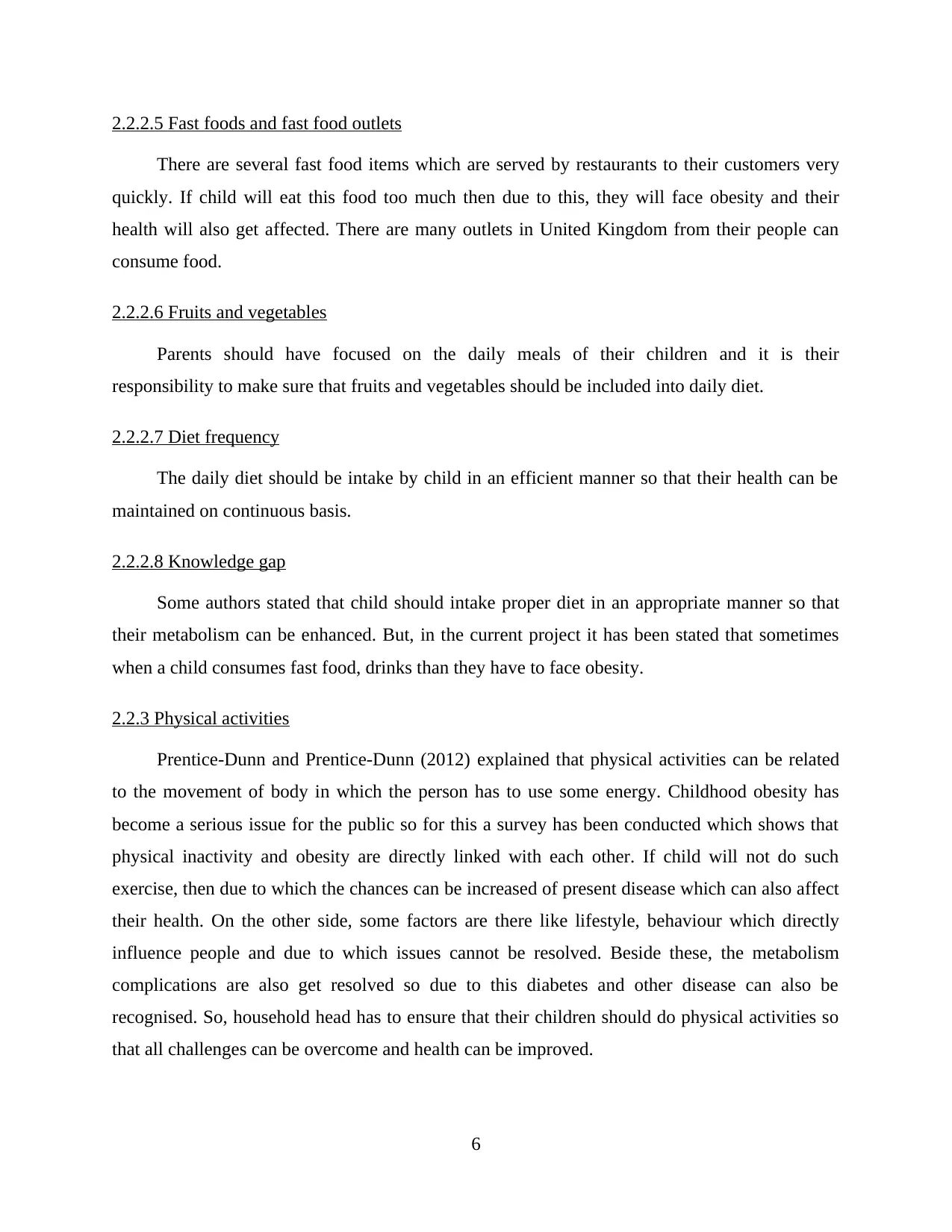
2.2.2.5 Fast foods and fast food outlets
There are several fast food items which are served by restaurants to their customers very
quickly. If child will eat this food too much then due to this, they will face obesity and their
health will also get affected. There are many outlets in United Kingdom from their people can
consume food.
2.2.2.6 Fruits and vegetables
Parents should have focused on the daily meals of their children and it is their
responsibility to make sure that fruits and vegetables should be included into daily diet.
2.2.2.7 Diet frequency
The daily diet should be intake by child in an efficient manner so that their health can be
maintained on continuous basis.
2.2.2.8 Knowledge gap
Some authors stated that child should intake proper diet in an appropriate manner so that
their metabolism can be enhanced. But, in the current project it has been stated that sometimes
when a child consumes fast food, drinks than they have to face obesity.
2.2.3 Physical activities
Prentice-Dunn and Prentice-Dunn (2012) explained that physical activities can be related
to the movement of body in which the person has to use some energy. Childhood obesity has
become a serious issue for the public so for this a survey has been conducted which shows that
physical inactivity and obesity are directly linked with each other. If child will not do such
exercise, then due to which the chances can be increased of present disease which can also affect
their health. On the other side, some factors are there like lifestyle, behaviour which directly
influence people and due to which issues cannot be resolved. Beside these, the metabolism
complications are also get resolved so due to this diabetes and other disease can also be
recognised. So, household head has to ensure that their children should do physical activities so
that all challenges can be overcome and health can be improved.
6
There are several fast food items which are served by restaurants to their customers very
quickly. If child will eat this food too much then due to this, they will face obesity and their
health will also get affected. There are many outlets in United Kingdom from their people can
consume food.
2.2.2.6 Fruits and vegetables
Parents should have focused on the daily meals of their children and it is their
responsibility to make sure that fruits and vegetables should be included into daily diet.
2.2.2.7 Diet frequency
The daily diet should be intake by child in an efficient manner so that their health can be
maintained on continuous basis.
2.2.2.8 Knowledge gap
Some authors stated that child should intake proper diet in an appropriate manner so that
their metabolism can be enhanced. But, in the current project it has been stated that sometimes
when a child consumes fast food, drinks than they have to face obesity.
2.2.3 Physical activities
Prentice-Dunn and Prentice-Dunn (2012) explained that physical activities can be related
to the movement of body in which the person has to use some energy. Childhood obesity has
become a serious issue for the public so for this a survey has been conducted which shows that
physical inactivity and obesity are directly linked with each other. If child will not do such
exercise, then due to which the chances can be increased of present disease which can also affect
their health. On the other side, some factors are there like lifestyle, behaviour which directly
influence people and due to which issues cannot be resolved. Beside these, the metabolism
complications are also get resolved so due to this diabetes and other disease can also be
recognised. So, household head has to ensure that their children should do physical activities so
that all challenges can be overcome and health can be improved.
6
⊘ This is a preview!⊘
Do you want full access?
Subscribe today to unlock all pages.

Trusted by 1+ million students worldwide
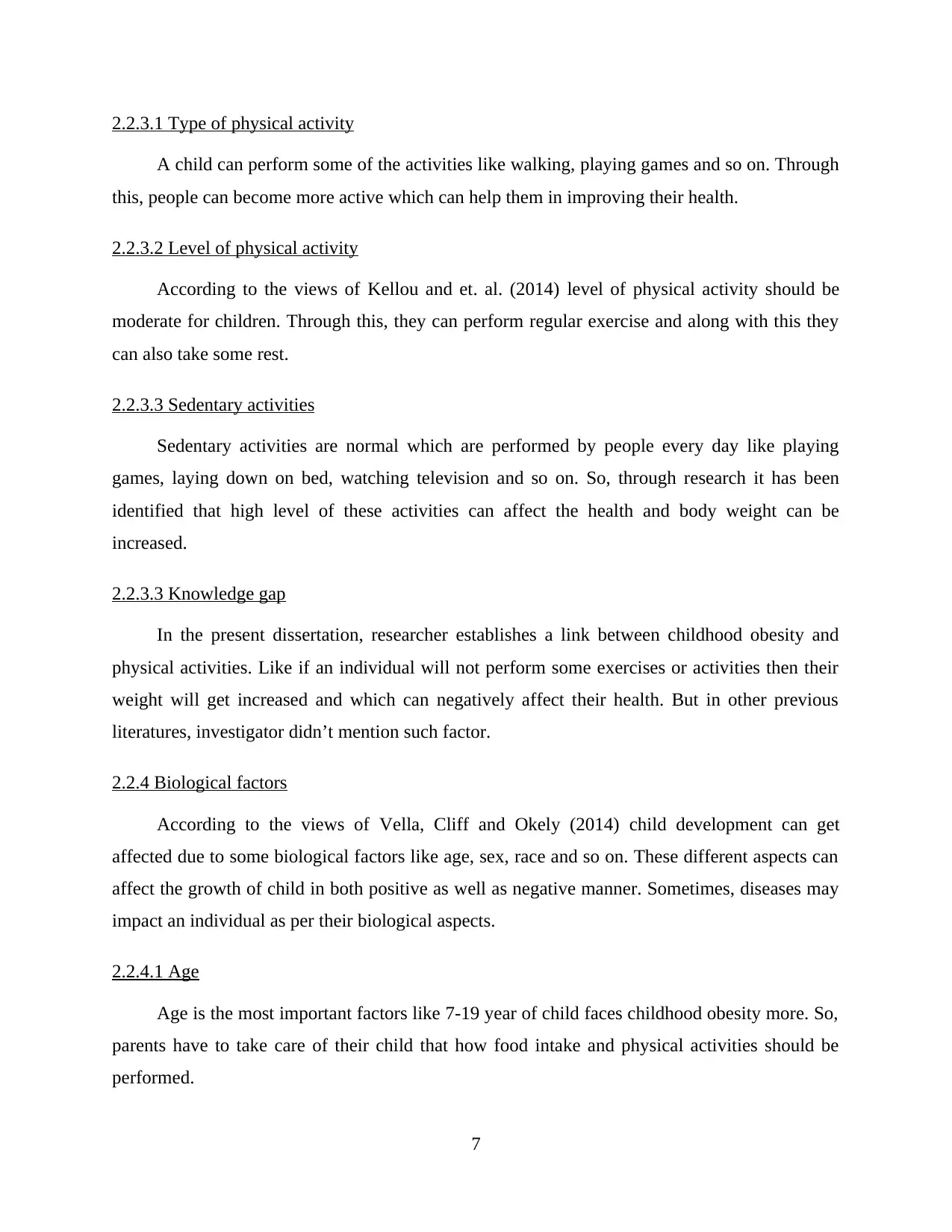
2.2.3.1 Type of physical activity
A child can perform some of the activities like walking, playing games and so on. Through
this, people can become more active which can help them in improving their health.
2.2.3.2 Level of physical activity
According to the views of Kellou and et. al. (2014) level of physical activity should be
moderate for children. Through this, they can perform regular exercise and along with this they
can also take some rest.
2.2.3.3 Sedentary activities
Sedentary activities are normal which are performed by people every day like playing
games, laying down on bed, watching television and so on. So, through research it has been
identified that high level of these activities can affect the health and body weight can be
increased.
2.2.3.3 Knowledge gap
In the present dissertation, researcher establishes a link between childhood obesity and
physical activities. Like if an individual will not perform some exercises or activities then their
weight will get increased and which can negatively affect their health. But in other previous
literatures, investigator didn’t mention such factor.
2.2.4 Biological factors
According to the views of Vella, Cliff and Okely (2014) child development can get
affected due to some biological factors like age, sex, race and so on. These different aspects can
affect the growth of child in both positive as well as negative manner. Sometimes, diseases may
impact an individual as per their biological aspects.
2.2.4.1 Age
Age is the most important factors like 7-19 year of child faces childhood obesity more. So,
parents have to take care of their child that how food intake and physical activities should be
performed.
7
A child can perform some of the activities like walking, playing games and so on. Through
this, people can become more active which can help them in improving their health.
2.2.3.2 Level of physical activity
According to the views of Kellou and et. al. (2014) level of physical activity should be
moderate for children. Through this, they can perform regular exercise and along with this they
can also take some rest.
2.2.3.3 Sedentary activities
Sedentary activities are normal which are performed by people every day like playing
games, laying down on bed, watching television and so on. So, through research it has been
identified that high level of these activities can affect the health and body weight can be
increased.
2.2.3.3 Knowledge gap
In the present dissertation, researcher establishes a link between childhood obesity and
physical activities. Like if an individual will not perform some exercises or activities then their
weight will get increased and which can negatively affect their health. But in other previous
literatures, investigator didn’t mention such factor.
2.2.4 Biological factors
According to the views of Vella, Cliff and Okely (2014) child development can get
affected due to some biological factors like age, sex, race and so on. These different aspects can
affect the growth of child in both positive as well as negative manner. Sometimes, diseases may
impact an individual as per their biological aspects.
2.2.4.1 Age
Age is the most important factors like 7-19 year of child faces childhood obesity more. So,
parents have to take care of their child that how food intake and physical activities should be
performed.
7
Paraphrase This Document
Need a fresh take? Get an instant paraphrase of this document with our AI Paraphraser

2.2.4.2 Sex
As per the views of Cooke and et. al. (2013) gender difference plays a most vital role into
the childhood obesity as there are some genes which are same in both girl and boy. But one Y
chromosome is different in the both individuals. So, one individual can learn and develop
differently as compare to other gender.
2.2.4.3 Race
Race is a traditional term which is used to categories people on the basis of some shared
characteristics. There are some biological characteristics on the basis of which people can be
differentiated like skin colour, genes and so on. So, by observing children it can be identified that
they are suffering from obesity or not.
2.2.4.4 Knowledge gap
Some other authors identify that biological factors are the one which can highly affect the
obesity in child. In this, age, sex and gender play an important role in affecting the health of
people.
2.2.5 Environment
As per the views of Freeland-Graves and Nitzke (2013) environment is also an important
determinant as biological. It is considered as an area in which an individual lives and get affected
due to some surroundings. There are three environments like physical, social and political which
explained below in detailed manner.
2.2.5.1 Physical environment
This environment will include some physical factors like climate, water and supply. For
children, this will act as an environment where they grow and learn. This can affect the mental
well as emotional health of people.
2.2.5.1.1 Place of residence
The residential place of people acts as a physical environment for a child. This is the place
where a child spends their whole time. It is the responsibility of parents to provide a peaceful
environment to them otherwise obesity can affect their health.
8
As per the views of Cooke and et. al. (2013) gender difference plays a most vital role into
the childhood obesity as there are some genes which are same in both girl and boy. But one Y
chromosome is different in the both individuals. So, one individual can learn and develop
differently as compare to other gender.
2.2.4.3 Race
Race is a traditional term which is used to categories people on the basis of some shared
characteristics. There are some biological characteristics on the basis of which people can be
differentiated like skin colour, genes and so on. So, by observing children it can be identified that
they are suffering from obesity or not.
2.2.4.4 Knowledge gap
Some other authors identify that biological factors are the one which can highly affect the
obesity in child. In this, age, sex and gender play an important role in affecting the health of
people.
2.2.5 Environment
As per the views of Freeland-Graves and Nitzke (2013) environment is also an important
determinant as biological. It is considered as an area in which an individual lives and get affected
due to some surroundings. There are three environments like physical, social and political which
explained below in detailed manner.
2.2.5.1 Physical environment
This environment will include some physical factors like climate, water and supply. For
children, this will act as an environment where they grow and learn. This can affect the mental
well as emotional health of people.
2.2.5.1.1 Place of residence
The residential place of people acts as a physical environment for a child. This is the place
where a child spends their whole time. It is the responsibility of parents to provide a peaceful
environment to them otherwise obesity can affect their health.
8

2.2.5.1.2 School environment
Child goes to school which they get different physical environment so this needs to be
ensured by teachers that their students will be able to get a peaceful environment. Through this,
they can understand new things and concepts. This can positively affect the health and well-
being of people.
2.2.5.2 Social environment
Christiansen and et. al. (2013) stated that social environment is a kind of environment in
which people live and develop relations with other individuals. It is also related to some culture,
values, beliefs. In such place, people can communicate with each other via some media tools and
techniques. It is based on some features like a society can never be static as this continuously
changing from one condition to another.
2.2.5.2.1 Socio-cultural environments
This is the collection of some factors which can influence the health of people in negative
way like values, literacy, education, ethical standards and so on. The childhood obesity is also
get vary as per the social cultural factors. If these factors may highly influence the risk for such
obesity and body weight.
2.2.5.2.2 Environment and ethnicity
Devís-Devís, Beltrán-Carrillo and Peiró-Velert (2015) explained that ethnicity is related to
the facts or belongingness to a particular social group who has some common tradition and
culture. Childhood Obesity is get increased in every ethnic group. Some of the reasons are like
genetics, socioeconomic status, culture and so on. These patterns can affect they different
physical activity and eating ability.
2.2.5.3 Political environment
This environment is related to some government, state, legislative policies and there are
some stakeholders who perform their operations in specific environment and influence the
system. The political factors affect the childhood obesity as due to globalization diet of an
9
Child goes to school which they get different physical environment so this needs to be
ensured by teachers that their students will be able to get a peaceful environment. Through this,
they can understand new things and concepts. This can positively affect the health and well-
being of people.
2.2.5.2 Social environment
Christiansen and et. al. (2013) stated that social environment is a kind of environment in
which people live and develop relations with other individuals. It is also related to some culture,
values, beliefs. In such place, people can communicate with each other via some media tools and
techniques. It is based on some features like a society can never be static as this continuously
changing from one condition to another.
2.2.5.2.1 Socio-cultural environments
This is the collection of some factors which can influence the health of people in negative
way like values, literacy, education, ethical standards and so on. The childhood obesity is also
get vary as per the social cultural factors. If these factors may highly influence the risk for such
obesity and body weight.
2.2.5.2.2 Environment and ethnicity
Devís-Devís, Beltrán-Carrillo and Peiró-Velert (2015) explained that ethnicity is related to
the facts or belongingness to a particular social group who has some common tradition and
culture. Childhood Obesity is get increased in every ethnic group. Some of the reasons are like
genetics, socioeconomic status, culture and so on. These patterns can affect they different
physical activity and eating ability.
2.2.5.3 Political environment
This environment is related to some government, state, legislative policies and there are
some stakeholders who perform their operations in specific environment and influence the
system. The political factors affect the childhood obesity as due to globalization diet of an
9
⊘ This is a preview!⊘
Do you want full access?
Subscribe today to unlock all pages.

Trusted by 1+ million students worldwide
1 out of 19
Related Documents
Your All-in-One AI-Powered Toolkit for Academic Success.
+13062052269
info@desklib.com
Available 24*7 on WhatsApp / Email
![[object Object]](/_next/static/media/star-bottom.7253800d.svg)
Unlock your academic potential
Copyright © 2020–2025 A2Z Services. All Rights Reserved. Developed and managed by ZUCOL.




